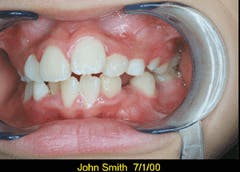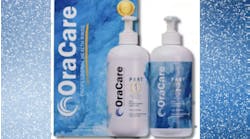The good news is that you can experiment with digital photography without investing in a digital camera.
Donald S. Sherman, DMD
Of all the new technologies in dentistry, one of the easiest - and initially least expensive - to use is digital photography. Most dentists use a 35mm camera in their office, so the transition to digital cameras is appealing.
The output from a digital camera can be used instantly. It can be incorporated into patient consultations, patient records, insurance predeterminations, Web pages, patient thank-you photos, and referral letters to specialists. The photos can be e-mailed and printed on your office printer.
Getting started can be confusing because this new technology is changing daily. A good digital camera can cost $1,000 or more. New models replace models that have only been available for 6-12 months! Prices drop on older models still on the market by 50 percent or more. The 35mm film photography market was never like this!
The good news is that you can get started in digital photography using your current 35mm camera. I recommend putting color-negative film in your camera, and have it processed not only into prints, but also onto a CD. The process is called Picture CD by Kodak. It should not be confused with a Picture Disk (a floppy disk) or a Photo CD (a CD designed for high-level amateurs and professional photographers). The Picture CD has been on the market for less than a year and was developed by Kodak for the amateur photographer. The CD contains a single roll of your pictures, as well as the software needed to manipulate the digital images.
The software on the disk will enable you to view and modify the images, enhance color, rotate the images, and add a patient`s name and the date taken to each image. You can print the images in various sizes. You can even print several images to a single 81/2 x 11-inch sheet.
You can arrange the photos into a slide show using the included software, and you can e-mail the images. The CD has a provision for exporting the images from the Picture CD for use in many Windows dental-practice-management programs, as well as Windows digital-imaging programs.
I use digital images to create new patient calendars and new patient photos on my Web page. I also import them into my practice-management software. If you want to import images into your practice-management software, you can export the digital images on the Picture CD in a variety of file formats. However, your practice-management software must have built-in, import-image features.
Where to take your film
If you would like to try using Kodak Picture CDs, take your film to almost any photo processor. Expect to pay about $10 more than the cost of normal processing to get a Picture CD with your prints. Most wholesale clubs, chain store pharmacies, and supermarkets will process film onto Kodak Picture CDs. To find a list of local film processors in your area who process onto Picture CDs, point your browser to www.kodak.com/go/ PictureCD. The Kodak site also has a learning center on digital photography. If you prefer mail order-processing of film, you can get non-Kodak versions of a picture CD from www.dalelabs.com and www.mystic colorlab.com.
The computer that you use for digital images - and a Kodak Picture CD in particular - should be at least a Pentium 90, with Windows 95, 98, or NT, and a minimum of 16MB of RAM. It also should have 40MB of hard-drive space and an up-to-date CD-ROM drive. Kodak offers support for Picture CD on the Mac. While Kodak recommends the preceding minimum requirements, I highly recommend more up-to-date hardware.
Gaining experience with digital images via Picture CDs can help you decide whether to invest in a digital camera and how you can best use the images in your practice. Several companies sell digital cameras and software designed for or modified for the dental market. Most digital cameras available to the general public today are like rangefinder 35mm cameras. The view through the camera viewfinder is not through the camera lens, but through a separate window above the camera lens.
Taking good close-ups
Rangefinders are fine for general photography, but not great for dental close-ups of the mouth. Most dentists today use 35mm single-lens-reflex, through-the-lens (TTL) film cameras,which offer the best choices for use in the dental office. Two groups of digital TTL cameras are made today. "Pro-sumer" or "professional consumer" models. have TTL viewing and other high-end features, without the high cost of digital cameras designed for professional photographers. Pro-sumer cameras cost from $800 to $1,800, while professional digital cameras cost from $3,500 to $10,000.
The pro-sumer cameras that I feel are best for dentistry are TTL cameras made by Sony and Olympus. The Sony FD-91 and its new replacement, the FD-95, record images on a floppy. This eases transfer of the images to a computer, but limits storage capacity for large images. It also increases the time it takes to record the digital image in camera memory after it is taken. This month, Sony will release an entirely new digital camera based on the FD-95, to be called the FD-1000. This camera will have a new method of image storage for digital cameras, a 31/2-inch CD. You will be able to take pictures and see them on your home computer, using your existing CD drive. You also will be able to download from the camera to your computer using the USB connection.
The Sony DSC-D770 is another good camera, using conventional memory storage. But the Olympus 2500L, with similar or better features, costs less. The majority of dealers selling digital cameras for dentists seem to favor the Olympus 2500L, currently available for less than $1,200. If you do not mind working with a non-TTL digital camera, the Kodak 290 and the Nikon 990, priced under $1,000, are popular choices for all-around digital photography. It can be used in an office setting and outside the office for family photos. The very popular Olympus 620 TTL has been discontinued, but it is still available from some Web sites for below $800.
If you don`t mind spending more money - and want to produce large, high quality prints (8x10) - consider the professional Nikon D1, for $5,000, the Minolta RD3000 for $3,700, or the soon-to-be-released Canon D30 for about $2,700. These prices may not include any lenses, but you can use 35mm camera lenses you already may own.
Must-have accessories
After you have purchased your digital camera, you need some accessories to permit close-ups of the mouth. The flash unit built into digital cameras are all located above the main camera lens. When you get close to the mouth with the camera, the flash temporarily blinds your patient - not very professional!
You will need a ring flash for better lighting in the mouth. Even if you own a ring flash designed for your 35mm film camera, it is very difficult to adjust flash timing and light output to match a digital camera. Fortunately, SR Electronics makes the RD50 ring flash ($250) for digital cameras.
In addition to a ring flash, you should consider rechargeable NiMH batteries ($50 for a set of four) or an AC adapter for your camera. Digital cameras with flash units and a display screen to view images consume lots of power. You also may need close-up, screw- on lenses ($75).
Lastly, to get the photos from camera memory to a computer, you should consider a flash memory reader. A flash memory reader ($75) plugs into your PC. You then take the flash memory containing your digital photos out of your camera and plug it into the reader. In most cases, this is a far faster transfer than using a cable that connects your camera directly to the PC. You will want to print out your images for office records, to send to dental labs or insurance companies, and to give to patients.
Printing your color images
Two principal technologies are available for color-photo printing in the dental office. The first is called dye sublimation. It uses color ribbons to produce beautiful images. The dye sub-printers that are cost-effective for the dental office are priced at about $400. They are made by Sony, Olympus, and Canon, among others. They produce images at a cost of about $1-$1.50 each and are limited to producing prints smaller than 4x6 inches. The ALPS dye sub printer, which produces larger prints, is no longer distributed in the USA.
The second printer technology for home or small office color-photo printers today is ink-jet printing. This is a a market dominated by Hewlett-Packard and Epson. HP has sold many HP970s and the similar HP P1000 series at prices from $400-500. However, the new Epson 870 ($280) and the larger Epson 1270 ($480) offer a great advantage. Almost all ink-jet inks printed on paper will age and fade considerably with time. A faded print is not much help as documentation in a patient record. The new Epson printers use special archival inks that will last for many years, equaling or exceeding the life of conventional color prints.
Once you have your images in your PC, you can either use mass-market digital-image-management software; import the images into your practice-management software (if it can handle imported images); or use a linked product like DICOM or Apteryx with Name Grabber to link to your office-management software. Good image-management software can handle digital images produced by digital cameras, digital X-rays, standard 35 mm cameras, and scanners.
In the next article, I will provide information on software for digital images and how to integrate these images into your office computer, regardless of the practice-management software you now use.
You can purchase the digital equipment mentioned in this article from companies that traditionally sell cameras to dentists and also from a variety of Web sites. If you would like information on where to purchase any of the equipment mentioned in this article, please e-mail me at [email protected]. I also provide extensive additional information on digital photography in my lectures at dental meetings. Please note that I do not sell or receive commission on any equipment I recommend.
All this adds up to a great time to get started in digital photography in your practice!
With Picture CD software included on the disk, you can add a patient`s name and the date taken to each image.







